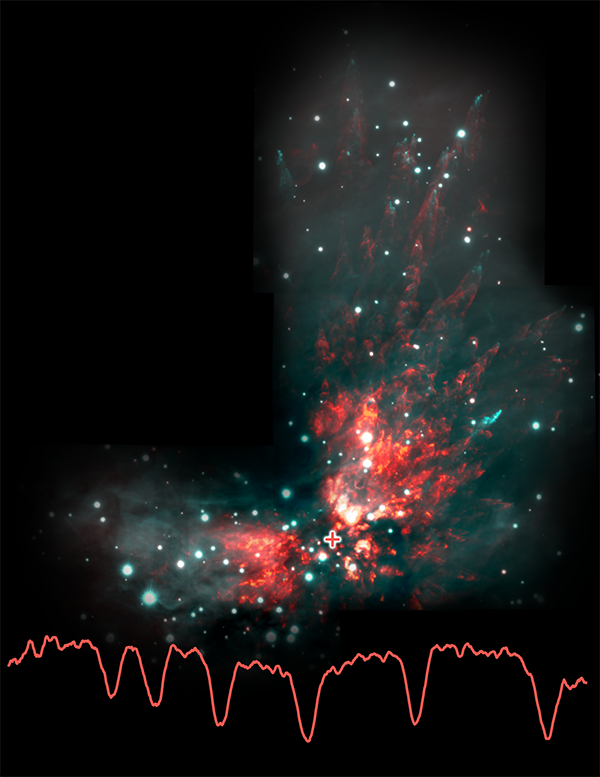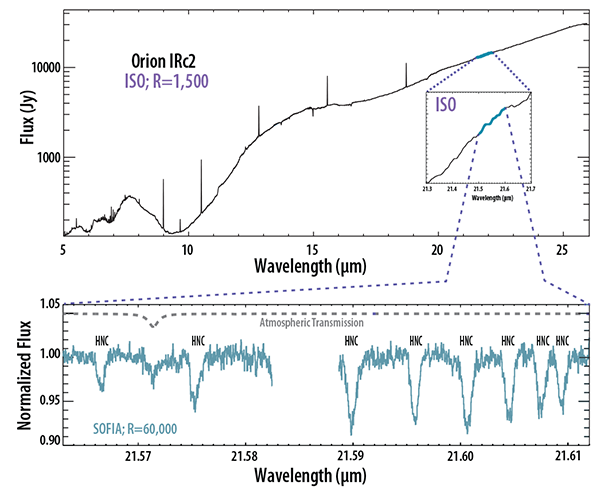Purpose of the Program
Chemical inventory around massive protostars were surveyed with high spectral resolution R>50,000 between 5 and 28 microns. This page describes multiple programs with overlapping targets and scientific goals. Hot Cores around massive protostars are chemically very diverse as many chemical and physical processes contribute to their molecular content. This spectral region contains the ro-vibrational transitions of many molecules known or expected to be abundant. The absorption line depths and profiles are unique signatures of the absorbing species and thus these data can be used to determine column densities and abundances relative to CO, as well as the kinematics and the physical conditions in the absorbing gas. These surveys greatly enhance the inventory of resolved line features in the MIR, making it an invaluable reference for the astrochemical scientific communities, especially JWST and ALMA communities. Previous surveys have been limited to radio, sub-mm and FIR wavelengths and limited MIR windows. Spectra from these surveys are rich in molecular lines and provide critical information on the hot cores’ physical conditions, including structure, orientation, age, temperature, and molecular abundances. Such a comprehensive data set will serve as an invaluable, and first of its kind, reference for the astrochemical scientific communities.
Principal Investigators
Xander Tielens (Leiden Observatory and University of Maryland) [program 05_0041]
Naseem Rangwala (NASA Ames Research Center) [programs 05_0043 and 06_0061]
Sarah Nickerson (NASA Ames Research Center) [program 09_0129]
Proposal IDs and Data Access
05_0041
05_0043
06_0061
09_0129
Summaries of the Proposals
05_0041: This program provides data between 5.4-8 microns for hot cores around massive protostars, AFGL 2591 and AFGL 2136, at R=50,000 resolution with high sensitivity (S/N~100). These data were combined with literature and ground-based studies to obtain a complete spectrum from 4.5 to 13 microns (Barr et al. 2020).
05_0043: This program conducted R=50,000 molecular line survey between 13.5 and 28.3 microns for the Orion hot core (towards IRc2). These data provide the best infrared measurements (to date) of molecular column densities and physical conditions - providing strong constraints on the current chemical network models for star forming regions. Cycle 6 program 06_0061 provides a targeted extension of this survey to include data around 7.5 microns.
09_0129: This program provides molecular line survey towards three chemically and morphologically diverse hot cores: AFGL 2591 VLA 3, Mon R2 IRS 3, and W3 IRS 5 by targeting key bandpasses between 7.4 and 25.7 microns that have been found to be molecular-rich in the hot core Orion IRc2 (05_0043). Comparison of archival EXES spectra between these hot cores show differences in the chemical species and their abundances. These data will be combined with archival data at shorter MIR wavelengths between 5.4 to 8 microns from 05_0041.
Sources Observed
Programs 05_0041 and 09_0129: AFGL 2136, AFGL 2591, W3 IRS5, NGC 7538 IRS 1
Programs 05_0043, 06_0061: Orion IRc2
Publications
S. Nickerson, N. Rangwala, S. W. J. Colgan, C. DeWitt, J. S. Monzon, X. Huang, K. Acharyya, M. N. Drozdovskaya, R. C. Fortenberry, E. Herbst, and T. J. Lee, The mid-infrared molecular inventory towards Orion IRc2. Ap (2022).
A. G. Barr, A. Boogert, J. Li, C. N. DeWitt, E. Montiel, M. J. Richter, N. Indriolo, Y. Pendleton, J. Chiar, and A. G. G. M. Tielens, Infrared H2O Absorption in Massive Protostars at High Spectral Resolution: Full Spectral Survey Results of AFGL 2591 and AFGL 2136. The Astrophysical Journal 935, 165 (2022).
S. Nickerson, N. Rangwala, S. W. J. Colgan, C. DeWitt, X. Huang, K. Acharyya, M. Drozdovskaya, R. C. Fortenberry, E. Herbst, and T. J. Lee, The First Mid-infrared Detection of HNC in the Interstellar Medium: Probing the Extreme Environment toward the Orion Hot Core. The Astrophysical Journal 907, 51 (2021).
A. G. Barr, A. Boogert, C. N. Dewitt, E. Montiel, M. J. Richter, J. H. Lacy, D. A. Neufeld, N. Indriolo, Y. Pendleton, J. Chiar, and A. G. G. M. Tielens, VizieR Online Data Catalog: IR high-res. sp. of hot cores of AFGL2591 & AFGL2136 (Barr+, 2020). VizieR Online Data Catalog J/ApJ/900/104 (2021).
Barr, A.G., and 10 colleagues (2020) High-resolution Infrared Spectroscopy of Hot Molecular Gas in AFGL 2591 and AFGL 2136: Accretion in the Inner Regions of Disks around Massive Young Stellar Objects, ApJ, 900, 104.
A. G. Barr, A. Boogert, C. N. DeWitt, E. Montiel, M. J. Richter, N. Indriolo, D. A. Neufeld, Y. Pendleton, J. Chiar, R. Dungee, and A. G. G. M. Tielens, Infrared Detection of Abundant CS in the Hot Core AFGL 2591 at High Spectral Resolution with SOFIA/EXES. The Astrophysical Journal 868, L2 (2018).
N. Rangwala, S. W. J. Colgan, R. Le Gal, K. Acharyya, X. Huang, T. J. Lee, E. Herbst, C. deWitt, M. Richter, A. Boogert, and M. McKelvey, High Spectral Resolution SOFIA/EXES Observations of C2H2 toward Orion IRc2. The Astrophysical Journal 856, 9 (2018).
Related SOFIA Observing Programs
02_0104, 03_0126, 04_0120, 04_0153, 09_0125, 75_0024, 76_0004, 76_0007
(Click on image for a larger version.)

